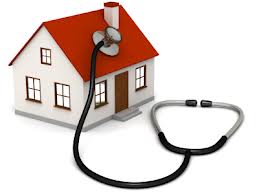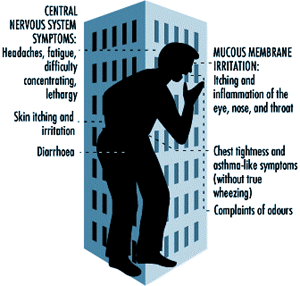- February 28, 2019
Sick Building Syndrome

Sick Building Syndrome is a name that has causes hair-scratching confusion for those who have not heard of it before. Huh? A building can be sick? The office building I spend 8 hours a day in might be drastically ill? In actuality, buildings can cause people to get sick, and when this happens, the diagnosis is Sick Building Syndrome.
The Environmental Protection Agency tells us that Sick Building Syndrome wreaks havoc with the American economy every year, wracking up a whopping total of 61 billion dollars in health-related costs, and employees working in a less productive way or simply missing work. How did this come to be?
To put things simply, most buildings are sick from mold or artificial building materials and poor indoor environment management. Both of these issues can cause acute health problems and some can even do some long term damage if exposed for extended periods of time. Here is some more information about this topic and its history.
Has Sick Building Syndrome always been around?
Most experts trace the origins of Sick Building Syndrome to the early 1980s. The 1970s saw John Travolta rocking that fabulous white suit in Saturday Night Fever and a generation hustling across America. It also saw an energy crisis of the highest order, when Arab states, for reasons of politics and protests, refused to sell oil to America and other Western countries.
The first reports of Sick Building Syndrome
In the early 1980s, office workers in America, Scandinavia, and the UK began to report common symptoms en masse; skin rashes, sinus problems, respiratory infections and more. Medical health professionals identified the source of these ailments as sick buildings, hence Sick Building Syndrome.
The World Health Organization, in 1984, released a report that concluded that up to 30 percent of buildings in the world are probably linked to symptoms of Sick Building Syndrome.
Mold and Sick Building Syndrome
Indoor mold growth can cause people to experience sick building syndrome as it releases mold spores into the air, some which release harmful mycotoxins. Health problems from mold are usually acute allergy like reactions; sore throat, runny nose, cough, itchy eyes, dizziness, etc. Mold complications may not be experienced by all as some people are more sensitive to these problems. For this reason, any employee or individuals complaints should be taken seriously and addressed immediately.
The best way to stop indoor mold growth from causing sick building syndrome at your place is to be active in prevention. Do everything you can to prevent moisture intrusion like inspecting windows, roofs, and plumbing for leaks and moisture. If you do come across a water damage problem, getting it addressed quickly and correctly could save you from future mold growth.
Air circulation
Before the energy crisis hit the American shores, the American Society of Heating, Refrigeration, and Air Conditioning Engineers (ASHRAE) recommended that all buildings be built so that fresh air continually circulated – 15 cubic feet of it per second. After the crisis, the ASHRAE decided that 5 cubic feet of fresh air passing by an office worker in a second would be fine.
Proper air circulation is vital for a buildings health and the well being of those inside. Getting fresh air in and artificial air with VOCs out is very important. Every building should have an appropriate sized HVAC unit. Bigger is not always better in this case, have an expert offer advice about your HVAC system if you are concerned.
Artificial building materials
The use of artificial building materials sky-rocketed: Natural materials such as stone and wood were increasingly replaced with mass-produced materials that off-gas volatile organic chemicals (VOCs). VOCs have been show to be unhealthy wen ingested, causing fatigue, headaches, dry coughs, dizziness, and nausea.
Let there be light
Windows were designed to be more energy efficient, to let natural light flow inside but not to open: New buildings were sealed tight against all external elements. Photocopiers, printers, computers and other machines continued to generate significant amount of heat.
The Present

Statistics are not regularly compiled on the prevalence of Sick Building Syndrome, though individual reports have shown that these sick buildings are still about.
The Environmental Protection Agency points out a startling fact – first, that North Americans spend about 90% of our time inside buildings. And, second, that these buildings generate 38.9 percent of all of the carbon dioxide emissions. These numbers feel very wrong to us as thinking humans. Surely we are spending too much of our time in buildings that are sending off massive amounts of carbon dioxide in the atmosphere? Perhaps we should, as they say, get out more?
A Look into the Future
The statistics that are available can be said to be cause for alarm, but not for panic. The rise of the green building may well do away with much of the negative effects wrought by its hermetically sealed cousin.
Green architects are putting much more natural light into their designs, ridding building owners of the need to blast florescent light into every crevice. There are affordable sustainable materials that are being chosen over mass-produced options, like carpet made from natural fibers.
Also, the humble plant is increasingly being used to purify the air in a massive office building that houses thousands of workers each day.
In the End
Sick Building Syndrome is a prevalent condition that has caused significant suffering for countless office workers. Increasing awareness about the possibility of an indoor environment causing negative health problems will go a long way in making workplaces address possible issues. If you think that your place of work may have indoor air quality problems due to asbestos or mold please notify your employer immediately. Ask for them to take action and if they refuse, contacting OSHA may be a good next step.
If you are a business owner and would like to have your indoor air quality evaluated for potential mold problems, please give us a call at 855-600-6653.

